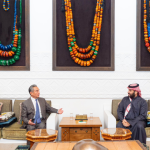Former President Donald Trump recently posted an AI-generated video on X that showcased him and Elon Musk dancing to the Bee Gees’ hit song “Staying Alive,” creating a viral sensation. This lighthearted portrayal of the two influential figures quickly captured the attention of millions and became an overnight sensation on the microblogging platform. The video surfaced shortly after Trump and Musk’s highly publicized interview, where many were anticipating Trump’s views on cryptocurrency, given his recent pro-crypto gestures. However, to the disappointment of many in the crypto community, the interview focused more on traditional political topics like U.S. border security and immigration, with no mention of cryptocurrency, leaving many to speculate on Trump’s intentions.
Despite the absence of crypto-related discussion in the interview, the viral AI-generated video and the unexpected content of the interview highlight the significant influence that figures like Trump and Musk have on public discourse, especially on social media platforms. The contrast between the lighthearted video and the serious nature of the interview underscores the evolving dynamics of political engagement in the digital age. There have been recent concerns about the use of AI in political settings, such as allegations made by Trump about Vice President Kamala Harris using AI to fake a crowd at a campaign event. This incident serves as a reminder of the ethical implications of AI technology in shaping public perception and discourse.
The AI-generated video featuring Trump and Musk dancing to a popular song not only showcased a fun and carefree side of the two influential figures but also sparked conversations about the intersection of AI, cryptocurrency, and public discourse. While the video generated widespread attention and amusement, the lack of discussion on cryptocurrency during the interview raised questions about Trump’s stance on the digital asset and the implications of his previous pro-crypto gestures. This incident sheds light on the evolving landscape of political communication in the digital era and the role that AI technologies play in shaping public narratives.
The viral nature of the AI-generated video and the unexpected content of the interview highlight the power of social media platforms like X in amplifying certain narratives and shaping public perception. Trump and Musk’s significant following on social media platforms allows them to sway public opinion and generate widespread engagement with their content. The use of AI technology in creating such viral content also opens up discussions about the potential for misinformation and manipulation in the digital space, especially in political contexts. As AI continues to advance, its role in shaping public discourse and influencing public opinion will become increasingly significant.
The juxtaposition of the lighthearted AI-generated video and the serious nature of the interview between Trump and Musk underscores the complex dynamics of digital communication and political engagement. While the video entertained millions and sparked conversations about the two influential figures, the absence of cryptocurrency discussion in the interview left many in the crypto community wondering about Trump’s stance on the digital asset. This incident serves as a reminder of the ethical considerations surrounding the use of AI technology in political settings and the potential impact on public discourse and perception.
In conclusion, the viral AI-generated video featuring Trump and Musk dancing to a popular song highlights the evolving dynamics of political engagement in the digital age and the significant influence that influential figures like Trump and Musk have on public discourse. The incident brings to light the ethical considerations of using AI technology in shaping public narratives and the potential implications for political communication and public discourse. As AI continues to advance, it is essential to critically examine its role in influencing public opinion and ensure responsible use of such technologies in political contexts.











